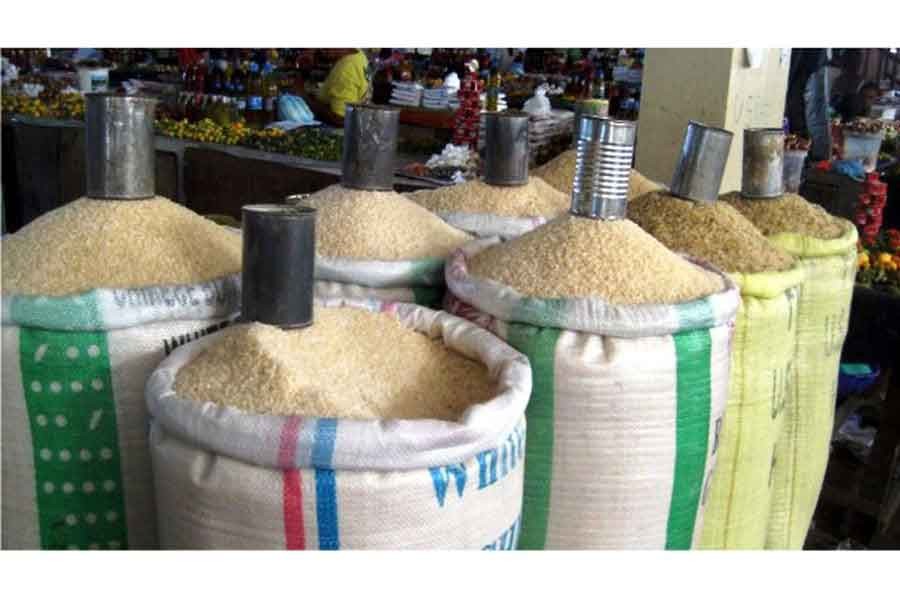Finance Minister AMA Muhith, of late, admitted that the common people were suffering because of the high price of rice. When the price crossed Tk 50 a kilogramme (kg), some poor people might have run out of their savings, he said.
The finance minister's observations came in the wake of the Dhaka-based think-tank SANEM's (South Asian Network on Economic Modelling) finding that 520,000 people have fallen into poverty due to sharp increase in the price of the staple this year. These people, according to the study, have gone back to 'below poverty line' in the past several months due to rice price hike.
Using a computable general equilibrium model, SANEM said last week it found a 35 per cent increase in the price of rice and the results show that there is a possibility of a rise in headcount poverty rate by 0.32 percentage points because of rice price hike this year.
Rice prices did hit a record high in the middle of August. During the middle of September, retail prices of coarse grains, consumed mainly by the poor and low income groups, shoot up to Tk 50-54 a kg in Dhaka city. The prices, however, came down below Tk 50 a kg the following month thanks to imports in large volumes and availability of subsidised rice through open market sales.
This week, coarse rice is being sold at Tk 44-46 a kg, which was Tk 40-45 a month ago, and Tk 35-38 a year ago. Prices of fine rice varieties rose 26 per cent year-on-year and coarse price 23.29 per cent. In line with finer varieties, the prices of coarse varieties of rice also increased last week.
Rice price hike has dealt a severe blow to the lower income groups of people, as they spend 80 per cent of their income to buy foods. However, the government believes that those who slumped below the poverty line would be able to overcome the situation once the prices are adjusted.
Analysts say such price hike is 'abnormal' and blame the rice trading syndicates as responsible for this. There is no reason why prices should rise during the harvesting season in the country and when imports reached an all-time high. However, traders attributed the hike to a record price surge of paddy during this ongoing Aman harvesting season amid expected low production of the staple.
Consumers Association of Bangladesh (CAB) also termed the price hike of rice abnormal during this harvesting season, in spite of huge imports. Its market reports showed that the milling cost of Swarna variety of rice will not be over Tk 39.8 a kg. But the variety is still being traded at Tk 54 a kg in the city retail markets.
Consumers usually expect a decline in prices during the harvesting season, which is absent this year. The overall production might witness a decline following the two spells of flooding that damaged the crops in both Boro and Aman seasons this year. But the fact remains that there is no supply shortage of rice now following the domestic harvest, large imports and almost stable international prices.
Meanwhile, the government should take action to minimise the price gap between the farmers' end and the consumers' end because the current paddy prices are all-time high considering any Aman harvesting seasons in the past.
Nearly 55 per cent of Aman harvest has been completed out of 5.56 million hectares of Aman coverage by December 20. The agriculture ministry is expecting 15.0 million tonnes of Aman rice this season.
The government claims that there is sufficient stock of rice now. It has brought 0.4 million tonnes of rice while 1.2 million tonnes more will be imported during the remaining period of this fiscal. According to SANEM, the government should formulate a 'rice policy' with respect to production, import, supply management and go for strategic agreements with rice exporting countries.
Despite accelerated economic growth in recent years, there has been much slower progress in poverty reduction because of slow employment generation, poor public spending on education and healthcare, and growing inequality. Recent rice price hike has made the poverty reduction efforts quite worrying.
What is apparent is that the millers, importers and their allied traders have hiked the price through syndicates. They need to be brought under close scrutiny to combat any artificial price hike. The government should, in the meantime raise its stock of rice to at least 1.5 million tonnes to put some impact on the mainstream market so that limited income groups could afford rice at reasonable prices.


